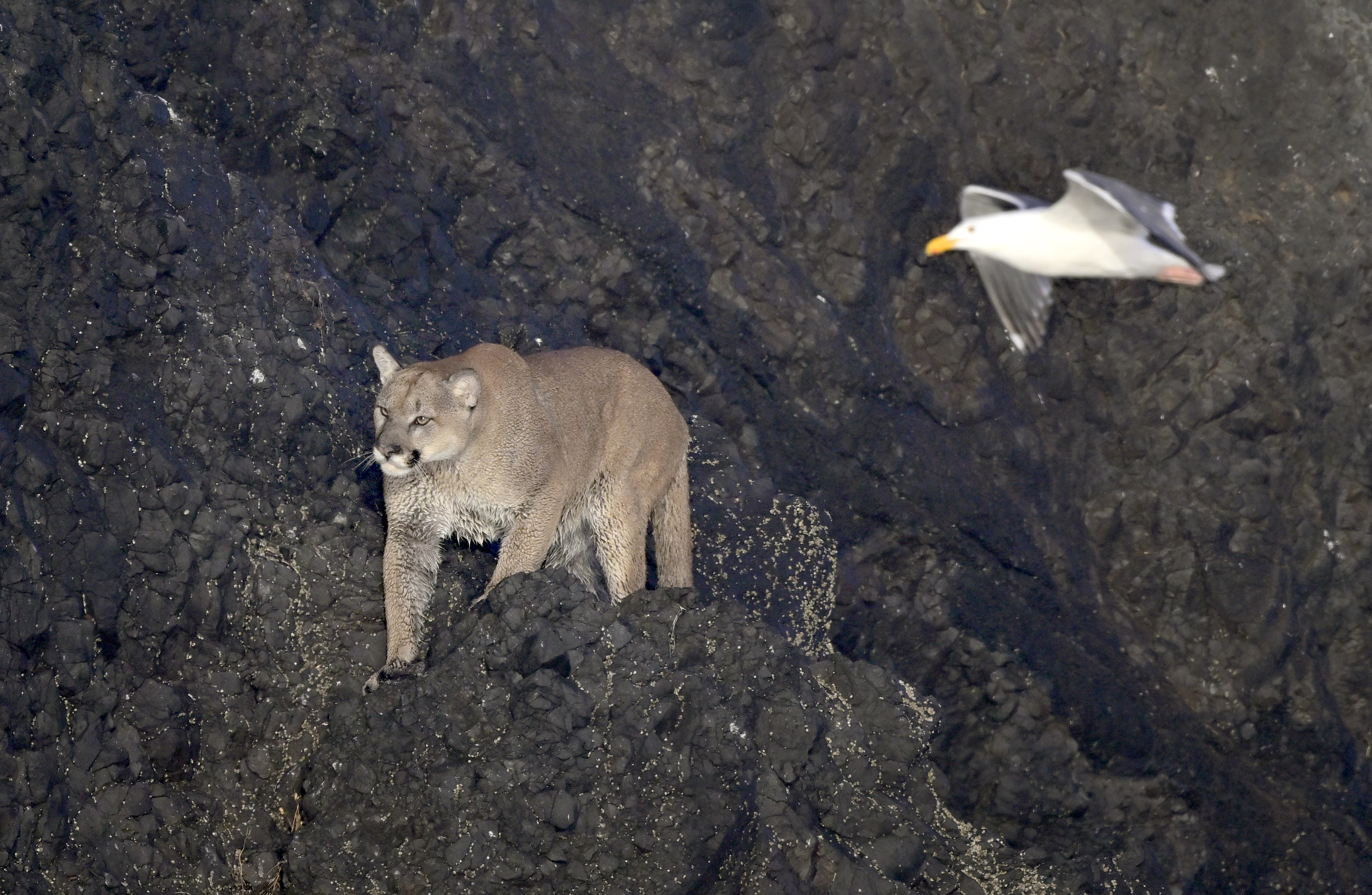
In this supplied photo, a cougar is seen climbing near Haystack Rock on Cannon Beach, July 16, 2023. The beach was closed on Sunday, and reopened on Monday.
Courtesy of Khula Makhalira
Cannon Beach was open again Monday after parts were closed Sunday because of a cougar on Haystack Rock.
The iconic animal has now left the iconic rock according to Cannon Beach Police. Authorities have seen tracks leading away from the landmark and a motion-activated camera, designed to catch wildlife photos, caught an image of it leaving.
A U.S. Coast Guard fly over with an infrared camera found no sign of the animal.
“It was definitely unusual for a cougar to be at Haystack Rock,” said Oregon Department of Fish and Wildlife spokeswoman Beth Quillian.
By nature, cougars are reclusive. They usually give people a wide berth. Cannon Beach at high season is not exactly quiet. But experts say cougars are also curious, like house cats except ones that can weigh up to 200 lbs.
Wildlife experts say the animal might have been in search of prey, like a seagull or puffin.
“Hopefully it is headed back up to the forested areas,” Quillian said. “Not to be seen again.”
Biologists think the cat may have walked to the rock at low tide.
“While the forested areas along the coast are prime habitat for cougars, it is unusual that a cougar made its way on to Haystack Rock,” said ODFW District wildlife biologist Paul Atwood, “Their primary food source is deer, but they will also consume elk, other mammals and birds.”
The 235-foot island is abundant with seabirds and sea life in the summer.
Quillian said cougars are also not afraid of water.
“It’s not unheard of for cougars to swim. They have been documented swimming between islands … up in Washington,” Quillian said. “But this is the first time we’ve seen anything like this in Oregon, and specifically at Haystack Rock.”
Mountain lions, as they’re also known, have a range of 100 square miles.

People couldn't get too close to Haystack Rock at Cannon Beach on Sunday like they did in this 2021 file photo. Parts of the beach were closed Sunday when a cougar was sighted on the rock, but the popular tourist destination reopened Monday after tracks were found that indicated it had left the area.
Stephani Gordon / OPB
A few miles south of Cannon Beach, the eastern section of the Loop Trail at Nehalem Bay State Park has been closed. There have been multiple cougar sightings but wildlife experts do not believe it’s the same cougar that appeared at Haystack Rock.
If you do come across a cougar, and it’s not backing away, treat it like a pack of unruly teenagers.
“You can raise your voice and speak firmly. Maintain direct eye contact,” Quillian said. “Don’t run away, because that can trigger a chase response in cougars.”
Experts say stay calm and stand your ground. If possible, back away slowly. Pick up children, but don’t bend down, turn your back or run. It’s a good idea to raise your arms to look larger, clap your hands or throw something, like a water bottle.
If the animal attacks, fight back as fiercely as possible. People have successfully fought off a mountain lion with rocks and sticks.
If you fall to the ground, try to get up again and remain standing.
Oregon is home to 6,000 cougars, but sightings are not common.
R. Brent Lyles, the executive director of the Mountain Lion Foundation, thanked Oregon officials for their thoughtful response.
“Although cougars pose little threat to humans when left alone, closing these trails and beaches as a precaution was a sensible step to prevent an encounter, assuage safety concerns and allow the cougars to return to less public areas,” he said in a statement.
“Sharing space with mountain lions works best when we take proactive measures to give these vital contributors to Oregon’s fragile ecosystems the space they need.”
Haystack Rock is protected as part of the Oregon Islands National Wildlife Refuge and closed to public.
From March through September, seabirds raise their young on Haystack Rock including tufted puffins, common murres, pigeon guillemot and black oystercatcher.
“It’s one of the best places on the entire West Coast to see tufted puffins in the wild,” said Dawn Harris, visitor services manager for Oregon Islands NWR. “The rock itself sees more than 350,000 visitors annually.”
Recent research with fecal DNA shows higher densities of cougars than previously believed along the coast. Animals from denser populations of the state appear to have migrated to the area.
